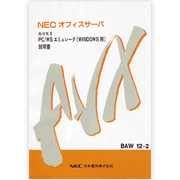NEC sold A-VX II as the operating system loaded on the two desktop models of the NEC office server system 7100 series and on the 14 floor-standing models of the NEC office server system 7200 series, which offered substantial performance increases over previous office computers. The 7200 series, in particular, pushed the performance envelope with multiple LSI chips — including NEC’s own single-chip IDP3Z microprocessor, a high-speed system bus, and the Database Engine, a specialized piece of hardware that accelerated file and relational database processing. The flagship model could be scaled up to support as many as 2,400 connected terminals — a number on par with mainframes — to address ever-increasing system sizes. To maintain high levels of reliability while supporting larger systems, the models were supplied with disk array units and hot-standby functions.
In the computer-aided software engineering (CASE) field, NEC offered Software Engineering Architecture/One (SEA/1), a software development assistant system that provided interactive program design, auto generation, and centralized asset management. In June 1994 with the A-VX II R 3.0 release, NEC supplied IDL Tool and Software Productivity Improvement Aid (SOFPIA), a software development assistant system that ran in a server-client configuration where software design was done on workstations and auto generation and asset management was done on the office computer.

- Home >
- Historical Computers in Japan >
- Office Computer OS >
- A-VX II
【NEC】 A-VX II
 |  | |
| Cover of the NEC A-VX II RDB/EUF II manual | Cover of the NEC A-VX II PS/WS emulator manual |
All Rights Reserved, Copyright (C) Information Processing Society of Japan
